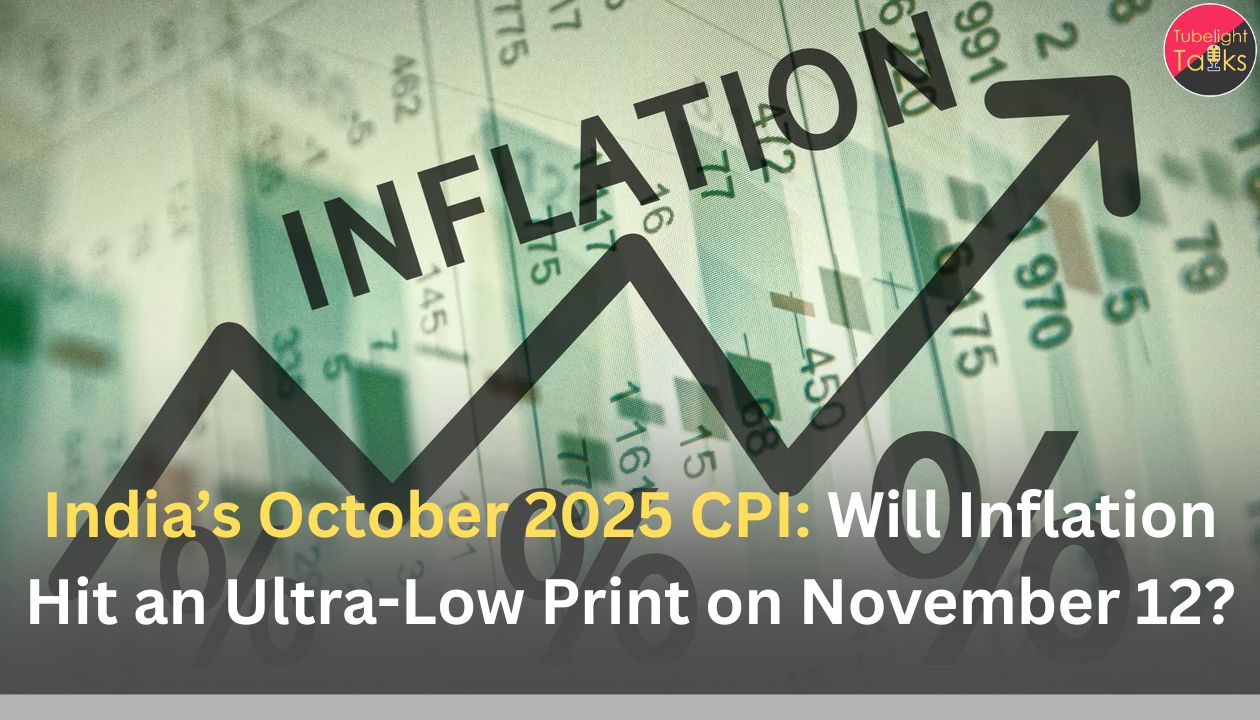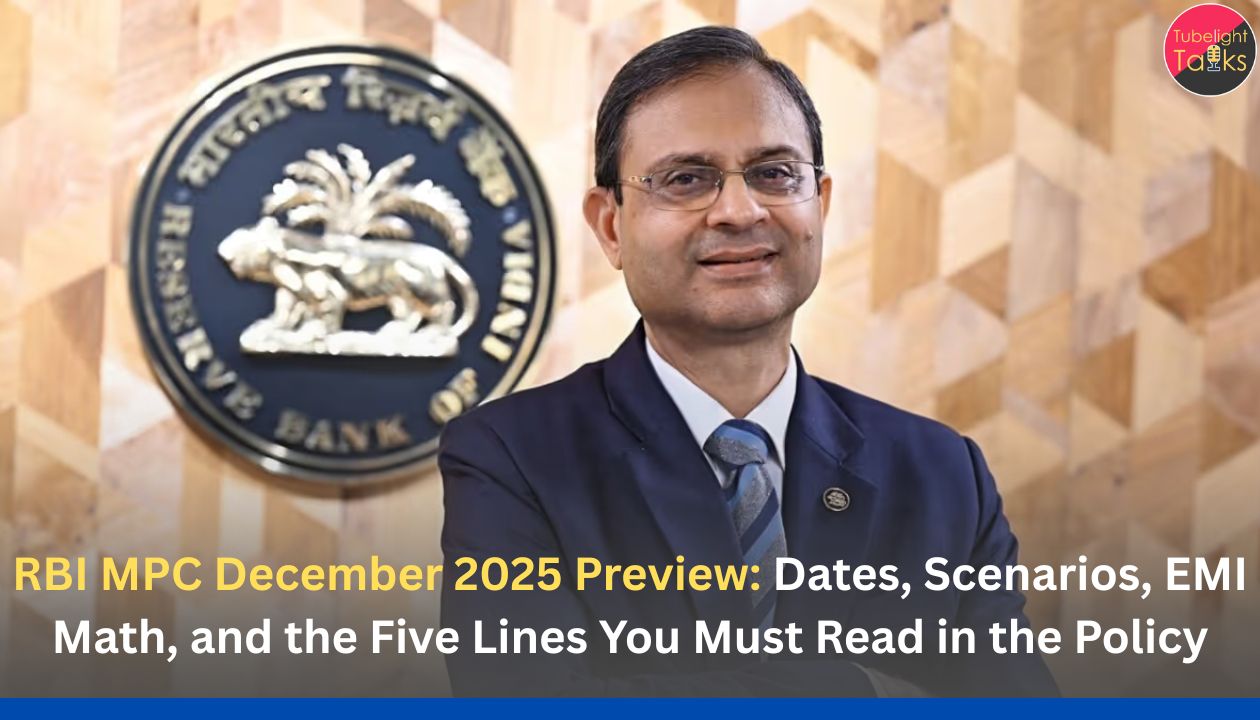India’s October 2025 CPI: India’s statistics office will publish the October 2025 Consumer Price Index (CPI) on Wednesday, November 12, 2025, as flagged in last month’s release. September’s headline inflation was 1.54% year-on-year, the lowest since June 2017, with food deflation pulling the overall rate below 2%. Market trackers now expect an even lower October print, citing falling vegetable prices and a powerful base effect.
In this newsroom-ready preview, we decode the timetable, expected numbers, drivers (food, fuel, core), the WPI-CPI bridge, RBI implications, and the key charts to prepare—anchored to MoSPI, DPIIT/WPI, IMD and other official sources.
The Calendar and What We Officially Know
MoSPI’s September press note states, verbatim, “Next date of release for October, 2025 CPI is 12th November, 2025 (Wednesday)”—so the clock is set. September headline CPI printed 1.54% y/y; MoSPI adds it was “the lowest year-on-year inflation after June, 2017.” Those facts anchor the current low-inflation narrative heading into the October release.
Why September matters for an October preview
The September note attributes the fall to a favourable base and declines in vegetables, oils & fats, fruits, pulses, cereals, eggs, fuel & light—a broad-based easing that many expect to persist into October, especially on perishables. That backdrop, plus early-October rainfall patterns and falling wholesale food indices, sets expectations for another soft reading.
Street Expectation: How Low Could October Go?
A Reuters poll of economists (Nov 7) points to a sub-1% October CPI print (median around 0.5% y/y), an “ultra-low” level not seen in more than a decade, driven by cheaper vegetables and a high base. Forecasts vary, but the directional call is emphatically lower. Keep in mind that polls are not the official number—MoSPI’s release on Nov 12 is the only authoritative print.
A quick look back: the slide since mid-year
By September, CPI had already dropped to 1.54% y/y; some months earlier, India printed sub-4% inflation (e.g., April 2025) as food normalized. The step-down has been most visible wherever vegetables corrected, which matters because food carries heavy weight in CPI.
Food, Food, Food: What the Trackers Say
WPI as a cross-check (not a substitute)
Official wholesale data show the WPI Food Index fell into deflation to −1.99% in September 2025, with the composite WPI easing as well. WPI is not CPI, but it’s a useful signal that upstream food prices were cooling, often flowing through to retail with a lag—supportive for a soft October CPI.
Tomatoes, onions, potatoes (TOP) and the “thali” cost
Multiple trackers reported month-on-month reductions in onion and tomato prices during October, lowering estimated household meal costs—consistent with the widespread perception of cheaper thalis through the month. That’s aligned with Department of Consumer Affairs’ mandate to monitor daily retail prices of essential commodities across hundreds of centres, even if not all micro-series are public without portal access.
Officially, DoCA’s Price Monitoring Division collects daily retail & wholesale prices for 22 essential commodities from ~555 centres—the backbone behind many price assessments.
Weather watch: IMD on post-monsoon rains
Early post-monsoon (Oct 1–15) rainfall was +27% vs LPA, per IMD’s weekly bulletin. Adequate moisture aids sowing and can steady perishables supply but can also cause local disruptions. Net-net, trackers saw improved availability outweighing local spikes—another reason markets expect a soft reading.
Core vs Headline: What To Watch Inside the PDF
Even if headline drops sharply, editors should check core CPI (ex-food & fuel) for stickiness in housing, health and education. MoSPI’s September note shows: health 4.34%, education 3.44%, housing 3.98% y/y. If October headline plunges mostly on food, core might not fall as dramatically. That matters for RBI’s policy narrative.
Why housing could change in the next CPI series
MoSPI is already revisiting the CPI base and has issued a discussion paper on proposed changes in the Housing index methodology (comments due Nov 20, 2025). For now, editors should stick to the 2012=100 series, but note that methodology updates are coming in the next base revision.
RBI Lens: What a Very Low CPI Could Mean
The RBI MPC held the repo rate at 5.50% in its Oct 1 announcement and flagged a neutral stance. An ultra-low October CPI will intensify expectations for space in coming meetings, but RBI typically looks through transient food volatility and focuses on durable disinflation in core. Editors: be cautious in implying policy changes from a single low headline print.
The RBI’s communication policy itself notes that the MPC resolution is released on the RBI website, with a Governor briefing—use that as your primary policy source.
Base Effects: The Quiet Mathematics of a Low Print
Two mechanics power the “ultra-low” setup:
- High base: October 2024 prices were relatively elevated; even flat m/m prices this year can produce low y/y inflation.
- Sequential food deflation: When perishables drop m/m into festival season, the y/y rate compresses rapidly.
September’s CFPI at −2.28% y/y shows how strong the base and food swing have become. If October repeats the pattern, the combined effect could push headline near the bottom of the year’s range.
CPI vs WPI: Reading Them Together
- WPI Food Index at −1.99% (Sep) is a clear upstream signal.
- Eight Core Industries up 3.0% (Sep) suggest broader supply conditions are not constricted—helpful for non-food components.
- CPI captures retail realities; historically, WPI moves precede CPI, but pass-through varies by commodity and margins. Editors should avoid treating WPI as a one-to-one predictor.
Rural vs Urban: September Split and October Clues
MoSPI showed rural headline at 1.07% and urban at 2.04% in September—rural disinflation was deeper, likely reflecting steeper drops in locally sourced perishables. For October, watch whether urban services (housing, transport, education) keep the city index stickier than rural.
What Could Upset the “Ultra-Low” Call?
- Weather pockets: Landslides/rains occasionally pushed up prices locally (e.g., hills in late October). The national index tends to smooth such patches, but localized spikes can nudge sub-indices.
- Export/stock dynamics: Sudden policy shifts in staples or pulses could pressure components. (Track official notifications; none material enough to overturn October’s bias have been flagged in the cited releases.)
- Statistical revisions: MoSPI revises the prior month to “Final” in each release. A revision to September’s components would slightly alter the base for October comparisons.
How to Read MoSPI’s PDF in Five Minutes (Editor’s Workflow)
- Page 1: Headline CPI and the key statement; confirm “lowest since …” and the official y/y.
- Annex I–II: Group and sub-group indices and inflation; scan Food & Beverages, Housing, Fuel & Light.
- Annex III–IV: State-wise and major states with high y/y—good for regional sidebars.
- Annex V: Key items (e.g., vegetables, pulses) with y/y rates—gold for infographics.
- VI–VII: Time series for quick trend charts back to 2013/14.
- Note the “Next date of release” for follow-ups; MoSPI always prints it in the note.
What the Household Feels: Prices vs Percentages
Even with a very low headline CPI, households judge inflation by the weekly grocery bill. Tracking firms and business media reported cheaper October thalis, consistent with observed dips in tomatoes and onions; broiler prices also eased m/m. Your explainer should reconcile lived experience (cheaper staples) with official math (base effects + broad indices).
Market & Policy Implications—Three Scenarios for Nov 12
Scenario A: Headline near 0.5% y/y (street low)
- Narrative: Food-led disinflation and high base dominate; core steady.
- RBI: Acknowledge, but wait for durability in core + winter vegetable cycle.
- Copy tip: Use the Reuters poll line for context; emphasise MoSPI’s official status for the number.
Scenario B: 1.0–1.5% y/y (still ultra-low)
- Narrative: Soft but not as extreme; core + services help floor the print.
- RBI: Unchanged stance; medium-term easing bias grows if core softens.
Scenario C: >1.5% y/y (surprise)
- Narrative: Local spikes or measurement surprises; check vegetables and housing.
- RBI: Markets reassess; focus returns to sticky components rather than
Prices, People, and the Duty to Be Fair
Inflation is not only a chart; it is the kitchen and the kirana. When essential items get cheaper, the ethical response—whether you’re a retailer, wholesaler, or wage payer—is to pass through gains transparently, avoid hoarding, and treat workers and customers fairly. Spiritual leader Sant Rampal Ji Maharaj discourses emphasise truthful dealings and responsibility at work—employers to be considerate, employees to work honestly.
For readers who want this values lens, see the talk on “Ideal Behaviour for Employer & Employees” and the book “Way of Living (Jeene Ki Rah)”, which root prosperity in righteous conduct—a compass as relevant to price setters as to policymakers.
Be Ready for the Print—And Ready to Explain It
Build your explainer in advance, then update with the official number
- Bookmark the MoSPI release and have templates for headline, food, core, rural/urban, and state charts ready to drop in.
- Add a WPI sidebar (Sep −1.99% food) and a weather box (IMD post-monsoon update) to show why food cooled.
- Include a policy paragraph (RBI repo 5.50%, neutral stance) and what a low print means—and does not mean—for rate expectations.
- For human context, stitch in thali-cost trackers and a line on TOP vegetables. Cite them clearly as third-party estimates, not MoSPI.
- After the release, update every reference with the exact MoSPI numbers, retain your methodology note, and flag any revisions to September.
Read Also: Financial Terminologies: A Breakdown of Key Financial Terms
FAQs: India’s CPI
Q1. When will MoSPI release India’s October 2025 CPI?
On Wednesday, November 12, 2025 (or the next working day). This date is printed in the September press note.
Q2. Why are forecasts calling it “ultra-low”?
Because vegetable prices corrected and the base effect is powerful. A Reuters poll pegs the median near 0.5% y/y, but the official number comes only from MoSPI’s release.
Q3. How does WPI help in a CPI preview?
WPI is wholesale; CPI is retail. Still, WPI Food Index at −1.99% (Sep) reinforces the signal that upstream food prices were cooling before the October CPI period.
Q4. What parts of CPI tend to stay sticky?
Core components like housing, health, education move slower. In September: housing 3.98%, health 4.34%, education 3.44%. They may not fall with food.
Q5. What is changing in CPI measurement?
MoSPI is revising the CPI base and has issued a discussion paper on Housing index methodology for the new series (feedback due Nov 20, 2025).
Q6. What does this mean for RBI policy?
A very low headline strengthens the disinflation story, but RBI looks for durable core relief. The MPC left repo at 5.50% on Oct 1 and maintained a neutral stance.










